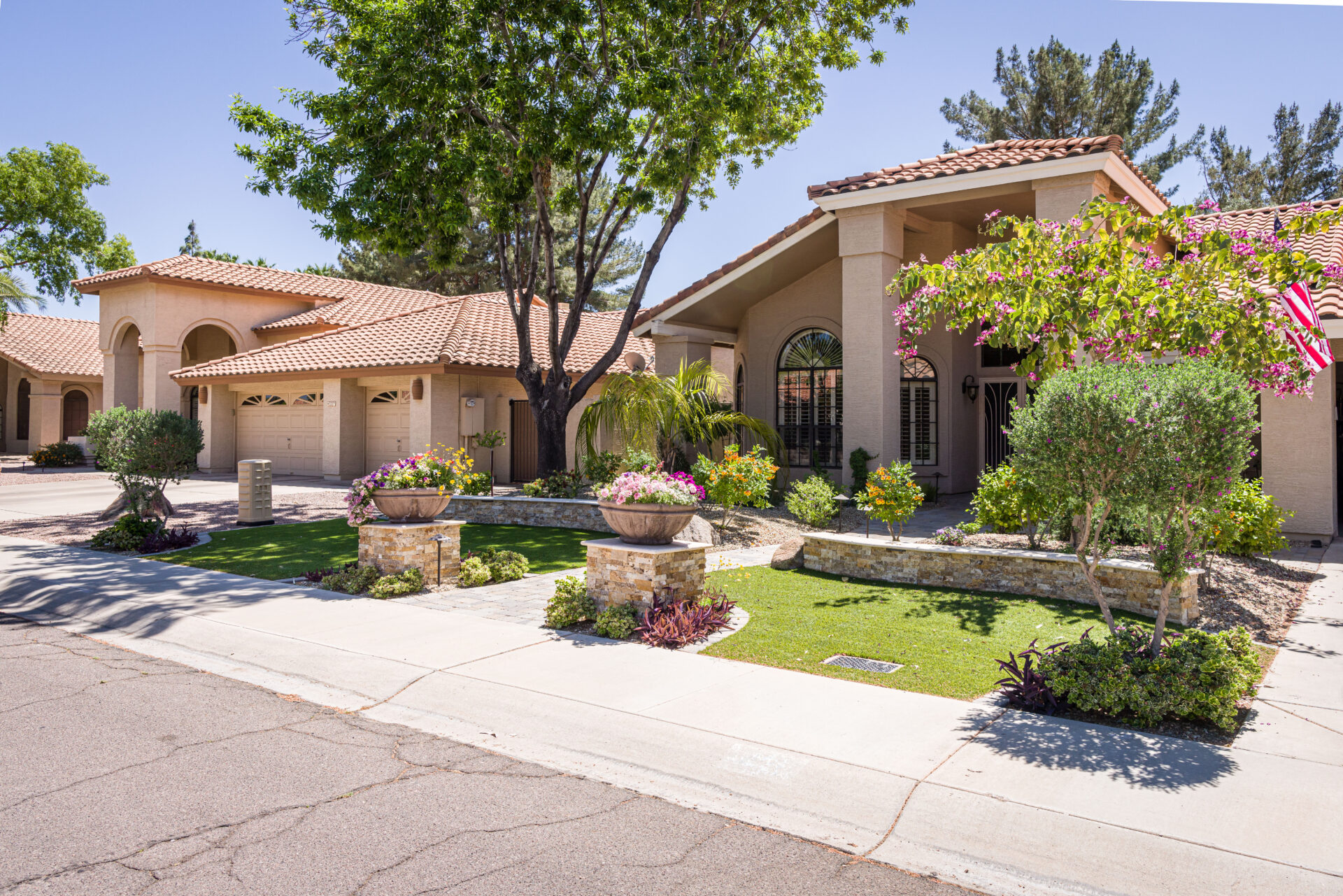
There’s a saying going around Nick Bastian’s real estate office in South Tempe in response to this question: “How many days do you think that house will be on the market?”
“The joke is how many hours will it be?” Bastian, a realtor with Realty Executives Tempe, said, laughing. “If a house is on the market for 10 days, we look at it and ask, ‘What’s wrong?’”
Despite recent inflation, rising mortgage interest rates, Russia’s war in Ukraine, continuing fallout from the coronavirus pandemic and an uncertain political climate in the U.S., the residential real estate market in South Tempe and West Chandler remains frenetic, Bastian said.
“Our market has been hotter than nationally,” he said, noting that some homes in the area are selling for 30 percent more than just two years ago. “More homes are under contract now than are for sale, and that’s certainly an indicator of strong demand. But we’re coming out of something you could almost call insanity. It might now just be in a frenzy.”
The Kyrene and Price corridors are highly desirable for myriad reasons, among them good schools, proximity to freeways and the airport, and a steady stream of business development that has brought higher-paying jobs in health care, technology, banking and construction.

Carol Royse, a real estate team leader with Keller Williams East Valley, says that even though prices have jumped sharply in South Tempe and West Chandler they still are behind other comparable areas in the U.S.
“The South Tempe and West Chandler markets were underpriced for so long that the inflation percentages and cost of living are just now catching up to other markets,” Royse said. “We still rank nationally undervalued for how much home you can buy.
“As pricing has increased, buyers have still been plentiful for homes in South Tempe. With average days on the market of 10 or less, sellers have realized equity gains as well as favorable terms, such as post possession after closing, appraisal waivers and inspection waivers. Buyers desire to be in custom neighborhoods, many with larger lots and gated communities, as well as some of the best public and charter schools.”
Those factors will keep South Tempe and West Chandler desirable for home buyers, she says.
“While 30 percent appreciation will be slowed, we should still see appreciation in the double digits,” Royse said.
According to December 2021 U.S. Census Bureau data, 269 people move into Arizona every day, 200 of them bound for the Phoenix metro area.
“We have a much more well-rounded job base, and that’s big for us. It will sustain us for a while, even with an increase in interest rates,” Bastian said. “But we don’t have enough houses to put people in.”

During the first week of May, there were only 52 single-family homes for sale within the ZIP codes of 85226, 85283 and 85284. In 85284, there are only four to five single-family homes for sale at any given time, and finding one under $500,000 is almost unheard of, he adds.
“It would be alarming if there were only 200 homes total,” said Bastian, himself a South Tempe resident. “I feel badly for young families and first-time buyers because the average sales price of these 52 homes is $700,000.”
However, as summer heats up in the Valley, there are signs that the Phoenix metro housing market is starting to cool a bit. Whereas some home sellers received 20 offers in the past, now they may expect just two or three, he said.
Randy Goff, marketing manager at Lucas Real Estate and owner/broker of Chandler Mortgage, says that in the past few weeks there has been a much needed uptick in local housing inventory.
“This is a direct result of the higher home prices and increased mortgage interest rates,” Goff said. “We expect this trend to likely continue throughout the rest of 2022.”
Michael Bell, senior loan officer at Security National Mortgage Co., said he, too, sees inventory slowly starting to rise. There has been a significant slowdown in mortgage loan applications and overall submitted offers since mid-April, he said.
“The biggest reason is the cost factor,” said Bell, who also lives in Tempe. “Taking into account home values and higher interest rates, for a lot of people it makes it more difficult to afford or justify owning a home right now.”
For example, the 30-year fixed rate six months ago was in the mid-3 percentile, he said, then in the mid-5s in May. Bell predicts it could go as high as 6.5 percent.
“But if you look at median interest rates over the last 50 years, we’re still well below that,” he said. “The last three years have been a great opportunity for people to lower their monthly payment and lock into a fixed interest rate, but it’s not forever.”

The average monthly mortgage payment for a home purchased this spring is 55 percent higher than for the same home a year ago. A $4,500 monthly payment now was $3,000 last year, Bell said.
“That, along with inflation, is really starting to become a big concern,” Bell said. “Everything is becoming more expensive to purchase and more difficult for people to sustain the same lifestyle they had last year.”
Goff points out that Maricopa County has been among the fastest-growing counties in the U.S. over the past decade.
“Phoenix is a desirable place to live and the business/jobs environment is extremely strong,” Goff said. “This should help stabilize the market both in the near and long term.”
According to data provided by Brooke Bogart, a Realtor for Keller Williams Realty in Tempe, active listings in the greater Phoenix area increased to 6,722 in April, from 5,403. Closings dropped to 8,825 from 9,640 in the same time period.
Bell predicts first-time homebuyers and people who can’t afford large down payments may soon be able to jump back into the market.
“Over the past year, if you didn’t have at least 10 to 15 percent to put down, the chance of your offer being accepted was low because there was so much competition,” Bell said. “A lot of agents are now starting to reach back out to people who couldn’t get a contract six months ago.”
Crystal-ball gazing into the housing market is tricky business, one that experts are reluctant to tackle.
“If you had asked me at the end of last year, I’d have had a very solid answer,” said Mark Stapp, executive director of the Master of Real Estate Development Program and the Fred E. Taylor Professor in Real Estate in ASU’s W.P. Carey School of Business. “But as of six weeks, two months ago, oh boy, I wouldn’t say all bets are off, but it’s becoming more difficult to see a more precise future.”
Contributing to the uncertainly, in addition to continuing global supply-chain issues, and the decreasing amount and rising cost of available land, is China’s COVID-19 lockdown along with rising prices due to the Ukraine war and inflation, Stapp said.
In attempting to tamp down inflation, the Federal Reserve raised its benchmark interest rate by half a percentage point on May 4, the largest increase in more than 20 years. But mortgage rates aren’t directly connected to that rate, experts say.
“What the Fed rate is telling us is money is becoming more expensive,” Stapp said. “That will trickle through the capital markets for sure, but will it be in lockstep (with mortgage rates)? Not necessarily.”
Prospective homebuyers boxed out of the market often have to resort to renting, but there are too few available properties in South Tempe and West Chandler. Chandler has passed Scottsdale as the most expensive rental market in the Valley.
“One thing that causes rents to go down is vacant homes, but we don’t have that now because there’s so much competition from institutional investors,” Bastian said.
In early May, just 32 single-family homes were for lease within the Kyrene and Price corridors, with the average monthly rent at just under $2,500, he said.
That’s a big concern for Stapp because an undersupplied rental market unfairly impacts certain people, those with less buying power.
“It’s very difficult for your average hourly worker or even a salaried worker who is a paraprofessional — the teacher, the firefighter, basic-services providers,” Stapp said. “This situation is not good for them.”
Royse agrees.
“For first-time home buyers, it is going to be impossible to become a home buyer in today’s market,” she said. “First-time home buyers are going to have to move further away from the city and live on the outskirts if they want to buy a home. Interest rates impact first-time buyers more than home prices, not to mention inflation, which also decreases first-time buyers’ affordability.”
Renters in metro Phoenix suffered an average 26 percent increase in rent payments last year, while the average increase in wages was 6 percent, Stapp noted. The simple answer is supply, he acknowledges, but, “we don’t control a lot of that,” given significant issues with supply chain and employment.
Additionally, the region has a history of and a mindset for keeping housing density relatively low, Stapp said.
“Growth patterns are pushing people out, rather than in-filling,” he said. “We have to be able to adjust to accommodate urban growth, and that requires significantly more density. But our land-use laws and public policies don’t support that.”
Without change, at least in South Tempe and West Chandler, there are few places to grow.
“There’s not a lot of vacant land, not much to build out,” Stapp said. “But the area is highly desirable, and will be continue to be so, especially in certain neighborhoods in certain locations.”
Wrangler New Publisher Don Kirkland contributed to this report

